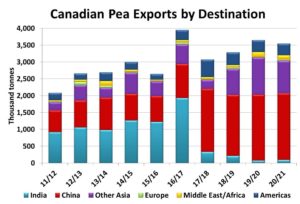Pulse Market Insight #166 JUN 26 2020 | Producers | Pulse Market Insights
Demand Side Critical for Pea Market
There’s a tremendous amount of attention focused on crop prospects for peas, and rightfully so, but the demand portion of the balance sheet is just as important this year. Maybe even more so.
The StatsCan acreage result is only the first step in the process of putting together a 2020/21 market outlook. From there, yield outcomes play a huge role in settling the supply questions. In fact, for each bushel change, it adds (or subtracts) 120,000 tonnes to supplies. And the differences in yield can be huge, from 44 bu/acre in 2013 to 32 bushels in 2015.
Based on expectations of roughly normal conditions, the early indication is that 2020/21 pea supplies will be roughly similar to last year. If that ends up being the result, it will then be demand that decides market direction. On this front, there are a few solid prospects and a few question markets. But let’s get the bad news out of the way first.
For those wondering if India’s import tariff reduction on lentils means there’s hope of the same for peas, I would say it’s not likely. Despite its official production estimate, the recently harvested Indian lentil crop was smaller than last year and there were far less government-held inventories this year. Simply put, lentil supplies are tight.
There aren’t any solid estimates of the Indian pea crop but all indications are that the desi chickpea crop (for which peas are a substitute) was a near record, and that means less need for imported peas. The bottom line is that India won’t be pushing to bring in more peas, at least yellows. India does have a small 75,000 tonne exemption for green peas which would have a small supportive impact on that portion of the market. The only question with respect to Indian pea needs could come from its next rabi crop in early 2021.
The good news is that the lack of exports to India isn’t a big deal; it’s just a continuation of the last couple of years. But there’s a big “if” attached to the outlook. It would also require that China remains a steady buyer of Canadian peas. As much as India was a dominant pea buyer five years ago, China has become even more so in the past 2-3 years.

Much of that Chinese demand is intended for the fractionation market which is continuing to experience growth and appears to be quite stable. That said, trade with China has become more vulnerable to diplomatic tensions in the last couple of years, so the outlook contains an element of risk.
Other than China, we’re expecting solid demand once again from other countries in Asia, particularly India’s neighbours. That business has grown in the past 2-3 years to help offset the loss in Indian imports. We could also see a bit more trade with the US, as pulse processing there is growing while its own crop will likely slip in 2020.
The best demand news comes from within our own borders, namely domestic processing. While some of the initial enthusiasm was premature, it appears that a couple of new fractionation plants will be in operation, likely around the middle of 2020/21. While the amount of peas utilized will only be a partial year’s total, it’s a step in the right direction. And if 2020/21 pea supplies are only just as large as last year, any additional demand from domestic processing will tighten up ending stocks a little bit more.
Pulse Market Insight provides market commentary from Chuck Penner of LeftField Commodity Research to help with pulse marketing decisions.
